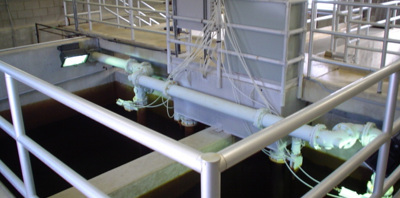Wastewater Treatment
Design
The existing wastewater treatment plant is designed to at a maximum daily flow rate of 950,000 gallons per day, with an average flow of approximately 600,000 gallons per day. The major treatment units consist of the following: bar screen, grit chambers, primary settling tank, flow meter, aeration tanks, final settling tanks, chlorination, sludge digestion, sludge drying beds and appropriate devices for controlling each.
Location
The existing wastewater treatment plant is located in the northwest corner of the village, on Westgate drive, just north of Main Street, U.S. Route 30. The effluent of the treatment plant is discharged into a tributary of Paramour Creek about 2,000 feet from its confluence with Paramour Creek. Paramour Creek flows westerly about three miles, where it forms the Sandusky River near Leesville. Paramour Creek is the headwater of the Sandusky River. There are no residential buildings located within five hundred feet of the plant site.
Water Treatment

The City of Crestline Water Treatment Plant is designed to remove iron, manganese and various gases from the raw water pumped from the City’s well field.
An aerator is located at the head of the plant, upstream of the detention tank. The purpose of the aerator is to oxidize iron and manganese and to remove a potion of the hydrogen sulfide and carbon dioxide gases in the raw water. The aerator also removes some volatile organic compounds. The oxidation of iron and manganese and removal of gases reduces the amount of chlorine and potassium permanganate which must be added to accomplish these reactions.
Water flows from the aerator to the detention tank where chlorine solution is added. The chlorine solution further oxidizes the iron in the raw water. Some of the oxidized iron will settle out in the detention tank.
Water from the detention tank flows to the gravity filters in the control building. The gravity filters are made up of 24” of Manganese Anthrasand with a 6” Anthracite Cap. The Manganese Anthrasand was coated with manganic oxides after it was installed in the filters. The coating process activates the filter media so that it can remove iron and manganese.
The filtration process is both a physical and a chemical process. The iron and manganese precipitates are filtered out by the filter media. The iron and manganese which is not fully oxidized by the potassium permanganate is oxidized a reaction with the filter media coating.
